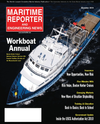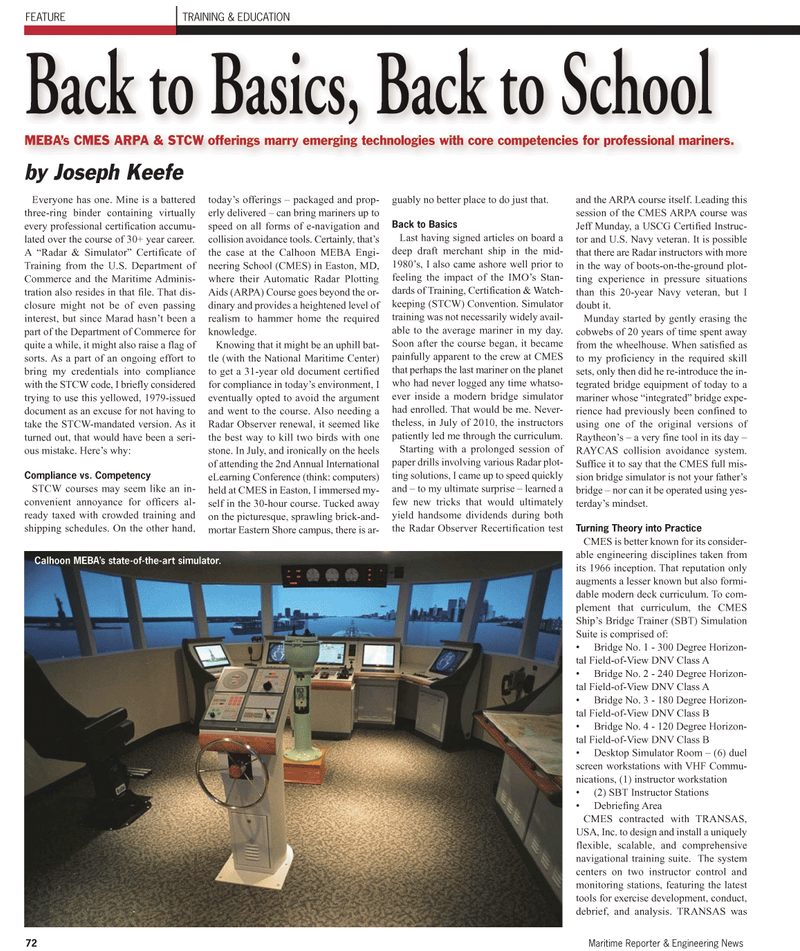
Page 74: of Maritime Reporter Magazine (November 2010)
Workboat Annual
Read this page in Pdf, Flash or Html5 edition of November 2010 Maritime Reporter Magazine
72 Maritime Reporter & Engineering News
TRAINING & EDUCATIONFEATURE
Everyone has one. Mine is a battered three-ring binder containing virtually every professional certification accumu- lated over the course of 30+ year career.
A “Radar & Simulator” Certificate of
Training from the U.S. Department of
Commerce and the Maritime Adminis- tration also resides in that file. That dis- closure might not be of even passing interest, but since Marad hasn’t been a part of the Department of Commerce for quite a while, it might also raise a flag of sorts. As a part of an ongoing effort to bring my credentials into compliance with the STCW code, I briefly considered trying to use this yellowed, 1979-issued document as an excuse for not having to take the STCW-mandated version. As it turned out, that would have been a seri- ous mistake. Here’s why:
Compliance vs. Competency
STCW courses may seem like an in- convenient annoyance for officers al- ready taxed with crowded training and shipping schedules. On the other hand, today’s offerings – packaged and prop- erly delivered – can bring mariners up to speed on all forms of e-navigation and collision avoidance tools. Certainly, that’s the case at the Calhoon MEBA Engi- neering School (CMES) in Easton, MD, where their Automatic Radar Plotting
Aids (ARPA) Course goes beyond the or- dinary and provides a heightened level of realism to hammer home the required knowledge.
Knowing that it might be an uphill bat- tle (with the National Maritime Center) to get a 31-year old document certified for compliance in today’s environment, I eventually opted to avoid the argument and went to the course. Also needing a
Radar Observer renewal, it seemed like the best way to kill two birds with one stone. In July, and ironically on the heels of attending the 2nd Annual International eLearning Conference (think: computers) held at CMES in Easton, I immersed my- self in the 30-hour course. Tucked away on the picturesque, sprawling brick-and- mortar Eastern Shore campus, there is ar- guably no better place to do just that.
Back to Basics
Last having signed articles on board a deep draft merchant ship in the mid- 1980’s, I also came ashore well prior to feeling the impact of the IMO’s Stan- dards of Training, Certification & Watch- keeping (STCW) Convention. Simulator training was not necessarily widely avail- able to the average mariner in my day.
Soon after the course began, it became painfully apparent to the crew at CMES that perhaps the last mariner on the planet who had never logged any time whatso- ever inside a modern bridge simulator had enrolled. That would be me. Never- theless, in July of 2010, the instructors patiently led me through the curriculum.
Starting with a prolonged session of paper drills involving various Radar plot- ting solutions, I came up to speed quickly and – to my ultimate surprise – learned a few new tricks that would ultimately yield handsome dividends during both the Radar Observer Recertification test and the ARPA course itself. Leading this session of the CMES ARPA course was
Jeff Munday, a USCG Certified Instruc- tor and U.S. Navy veteran. It is possible that there are Radar instructors with more in the way of boots-on-the-ground plot- ting experience in pressure situations than this 20-year Navy veteran, but I doubt it.
Munday started by gently erasing the cobwebs of 20 years of time spent away from the wheelhouse. When satisfied as to my proficiency in the required skill sets, only then did he re-introduce the in- tegrated bridge equipment of today to a mariner whose “integrated” bridge expe- rience had previously been confined to using one of the original versions of
Raytheon’s – a very fine tool in its day –
RAYCAS collision avoidance system.
Suffice it to say that the CMES full mis- sion bridge simulator is not your father’s bridge – nor can it be operated using yes- terday’s mindset.
Turning Theory into Practice
CMES is better known for its consider- able engineering disciplines taken from its 1966 inception. That reputation only augments a lesser known but also formi- dable modern deck curriculum. To com- plement that curriculum, the CMES
Ship’s Bridge Trainer (SBT) Simulation
Suite is comprised of: • Bridge No. 1 - 300 Degree Horizon- tal Field-of-View DNV Class A • Bridge No. 2 - 240 Degree Horizon- tal Field-of-View DNV Class A • Bridge No. 3 - 180 Degree Horizon- tal Field-of-View DNV Class B • Bridge No. 4 - 120 Degree Horizon- tal Field-of-View DNV Class B • Desktop Simulator Room – (6) duel screen workstations with VHF Commu- nications, (1) instructor workstation • (2) SBT Instructor Stations • Debriefing Area
CMES contracted with TRANSAS,
USA, Inc. to design and install a uniquely flexible, scalable, and comprehensive navigational training suite. The system centers on two instructor control and monitoring stations, featuring the latest tools for exercise development, conduct, debrief, and analysis. TRANSAS was
Back to Basics, Back to School
MEBA’s CMES ARPA & STCW offerings marry emerging technologies with core competencies for professional mariners. by Joseph Keefe
Calhoon MEBA’s state-of-the-art simulator.

 73
73

 75
75
